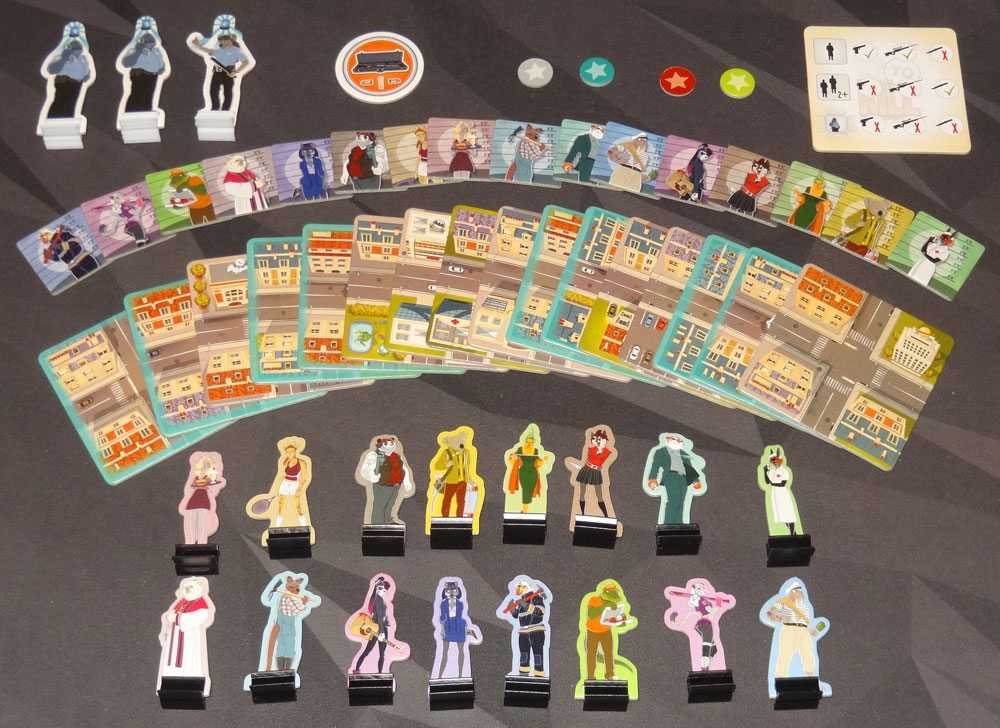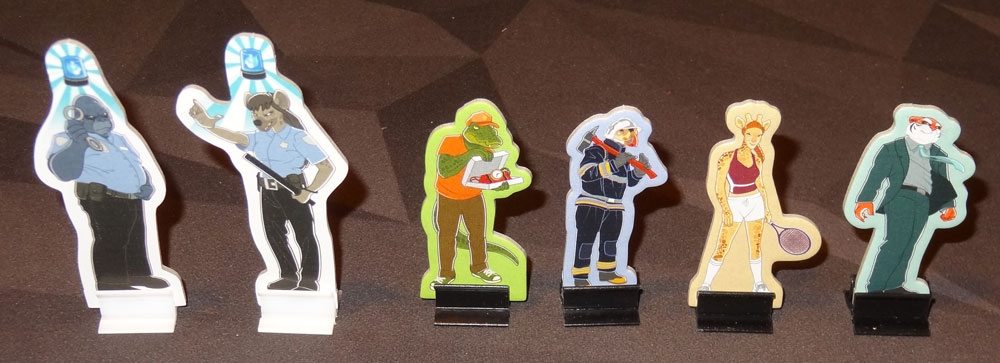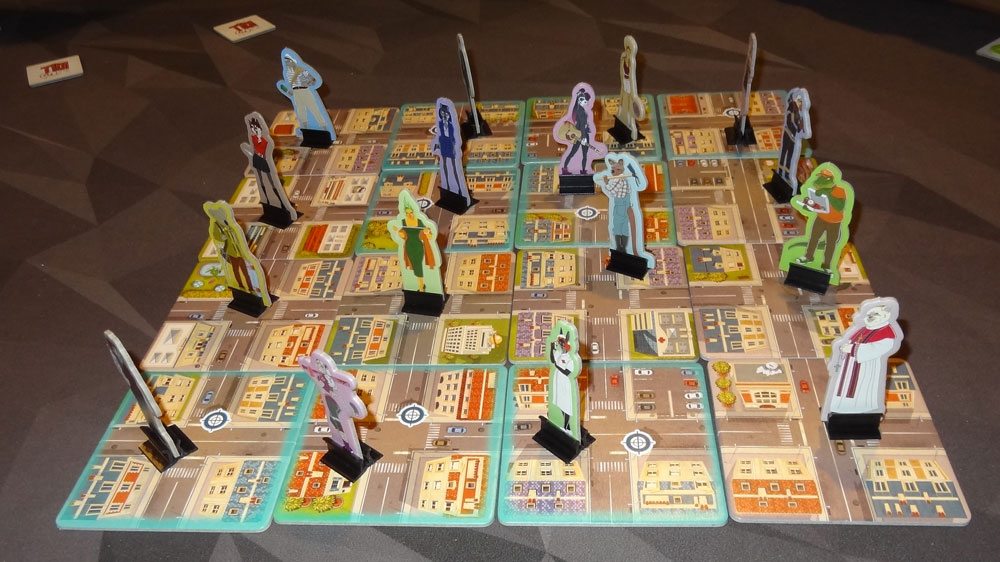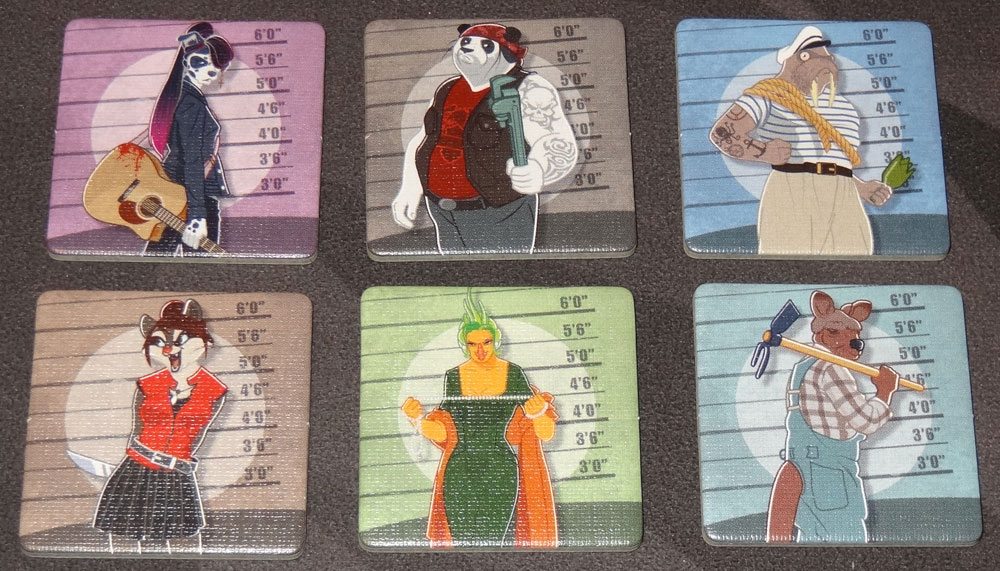“Reaping the Rewards” is a series of posts focusing on finished products from crowdfunding campaigns. Today’s topic is 10 Minutes to Kill, a quick game about animal assassins. I didn’t actually know about the Kickstarter at the time it ran in 2015, but came across the game at Gen Con 2016 at the Dude Games booth.
It’s a dog-eat-dog world out there—or maybe a rat-bombs-panda world? A cat-slices-walrus world? 10 Minutes to Kill is a game about colorful animal assassins trying to find and eliminate their targets, without getting caught.
At a glance: 10 Minutes to Kill is a game for 2 to 4 players, ages 14 and up, and takes about (you guessed it!) 10 minutes to play. It retails for $29.99. The theme is about assassins eliminating their targets (and each other), so that’s probably the primary reason for the age rating, though the gameplay itself could probably work for players as young as 8 or 10, if you’re okay with them being ruthless killing machines. It was funded on Kickstarter in 2015 by La Boite de Jeu, and is distributed by Dude Games, with the US release coming this spring. (It is now available for pre-order on Amazon.)

Components
- 16 character standees
- 3 police standees
- 16 character tiles
- 16 location tiles
- 1st player token
- 4 hitman tokens
- 1 reminder tile
The character standees include black plastic bases, and the police have white plastic bases.

The component quality is nice: all of the bits are nice, sturdy cardboard that punches out cleanly. The artwork for the characters by Pauline Détraz is excellent: all of the characters and the police are anthropomorphized animals, and pretty much all of the characters look suspicious. (As they should: every one of them could be a potential hitman.) Most of them are carrying weapons of some sort, or at least something that could be used as a weapon. If there were a comic book featuring these characters, I’d read it. The one odd thing to me is that, of the three police, two of them are the same exact illustration. It’s because one additional illustration was unlocked as a Kickstarter stretch goal, but it does seem weird that there’s only one repeat in the entire game.
The coaster-sized location tiles show various city intersections—some have a blue border and a target icon on them, representing high ground. These tiles are fine but not particularly exciting.
The 1st player token is a cardboard disk that shows a rifle in a case and two bullets, but it’s not entirely clear why it’s necessary. Other than taking the first turn, there’s no other reason to know who is the starting player for the game, and turns are short enough that you don’t need to pass it around as an active player token, either.

How to Play
You can download a PDF of the rules here.
The goal of the game is to score the most points by eliminating your targets and either killing or arresting other hitmen.
To set up, lay out the 16 location tiles however you like, as long as each tile is touching at least one other tile. (You can try a 4 by 4 grid the first time you play, just to make it easier.) Then randomly place one character on each location, and set the 3 police to the side.
Turn all of the character tiles face down and shuffle them. Each player takes a hitman token and a character tile, secretly looking at it. The token is placed on the tile. Then each player gets three more character tiles—these are their targets, and are also kept secret from the other players.

On your turn, you get 2 actions, which can be spent to move characters (or police), investigate a character, or kill a character. You may repeat the same action except for killing a character—only one kill per turn.
Move: Move any character or police on the board to any other location.
Investigate: If a police occupies the same tile as another character, you may investigate that character. Choose a player, and ask if that character is their hitman. If it is, they reveal their hitman tile and you take both the standee and the tile and place them in front of you for scoring. If it is not, then nothing else happens. (You must ask a specific player—other players do not answer if you investigate their character but ask the wrong player.) Note: An arrested player is not out of the game, but can continue to take movement and investigate actions until the game ends.

Kill: Your hitman has three weapons, a revolver, a rifle, and a knife. Guns may only be used if your hitman is alone on its tile, because otherwise there would be witnesses. The revolver can kill any character on an adjacent tile. The rifle can kill any target in a straight line (orthogonal only) from your hitman, but only if your hitman is on a blue-bordered tile. The knife can only be used to kill a target on the same tile, and will not be witnessed by other characters. However, police are much more observant: you may not make a kill with any weapon if there is a police on the same tile as or orthogonally adjacent to your hitman.
If you kill one of your targets, flip over the target tile and place the figurine on it. If you kill a character that is not one of your targets, you ask if it is anyone’s hitman. If so, they give you their hitman tile and you place it with the standee lying down in front of you. If it was somebody else’s target, they don’t say anything, and you take the standee in front of you.
After a kill, a police is placed on the location where the character died, and then at the beginning of the next player’s turn, they will move all non-police characters from that location to other locations of their choice. First, use the police that are set aside, and once all police are on the board, move police around on the board.

The game ends either when a player has killed all 3 of their targets, or when all hitman have been either killed or arrested. Scoring is as follows:
- 2 points if your hitman was not arrested or killed
- 1 point per target you killed (no points for targets killed by other players)
- 1 point per arrested hitman
- 3 points per killed hitman
- -1 point per non-target killed
Highest score wins; tie goes to the player who was last to lose their hitman.
The Verdict
I first saw 10 Minutes to Kill at Gen Con this year (I’d missed the Kickstarter) and I was really intrigued by the deduction aspect of the game. Dude Games is a new publishing branch of Distribution Dude, a Canadian games distributor that handles several publishers, and is branching out to bring those games to the US market, so it has taken a little while since Gen Con to get the distribution channels prepared.
I think it’s hard to review this game without addressing the elephant in the room—and I don’t mean one of the animal characters, because there isn’t an elephant there. I mean, this is a game about killing: sure, they’re cartoony animal-people, which I suppose helps distance it a little from the real world, but the fact is if the idea of killing off targets is distasteful to you, then you probably shouldn’t play this game. It is interesting to me, though, that although there are so many tabletop games (I won’t even get into videogames here) where gameplay represents battle, and pawns are added and removed throughout the game, spaceships get blown up, and so on, something about this one feels a little different. Maybe it’s because in 10 Minutes to Kill the killing is an impersonal job, rather than a battle? I’m not sure. Of course, despite the specifics of how you eliminate your targets in this game—knife, gun, rifle—the actual physical act feels rather dry: you remove a pawn from the board. It’s not generally a visceral experience.
What is visceral, though, is the fear of being found out, and that’s what the game is really about: staying hidden in plain sight. The game is sort of like a logic puzzle, with bluffing. Not only do you need to get all the appropriate pieces into their places so that you can make your move, but you also need scapegoats, and you need to get everyone in place without anyone else figuring out who you really are.
Of course, you’re also trying to track down the other assassins at the same time: unlike games like Scotland Yard or Letters From Whitechapel, everyone’s hiding in this game, and figuring out somebody else’s identity can be just as important as staying hidden. One interesting aspect is in the difference between arresting or killing a suspected hitman: there’s no penalty if you’re wrong when you interrogate somebody with a police, but you get more points for killing an opponent than arresting them. Of course, arresting somebody also doesn’t reveal your own location, while killing another hitman could potentially give away your own identity, making you a target for somebody else.

I particularly liked the 4-player game, because then all of the character tokens are in play: every single one is either a hitman or a target, which means everyone possesses information about a quarter of the characters. If you set up a kill so that there are three potential suspects, it’s possible that the two fake suspects both belong to another player, in which case they’ve just figured out who you are. It means you have to be a little more careful about when you act, and it helps to have a lot of potential suspects. And the other thing you have to watch for is that you need to have some overlap in your suspects from one kill to another—if your hitman is the only common suspect, you’ll be found out quickly for sure!
Realistically the game sometimes takes longer than 10 minutes to play, but it’s usually fairly quick at any rate, and one that you may play a few times in a row as you realize mistakes you’ve made and want to try again. Although the game rules aren’t too complex, it can be easy to forget one or two of the rules—it’s possible for people to make an error and eliminate a target even when they technically weren’t able to. And since it’s hard to remember the exact board state, it might not even be something that people will realize later, either. Fortunately, though, since it is a short game, even if somebody flubs it, you can just set up and play again.
For more information, visit La Boite de Jeu’s website, or place your order on Amazon.
Review copy provided by Dude Games.





